Top Tips For Surf Fishing
A compilation of some great surf-fishing tips to help you find and hook lots more fish.
- How to find the fish you are after
- Tips on rigs and bait for some popular surf fish
- Types of rigs
- Types of bait
- Tips on cost-effective fishing equipment
Definition of "Fishing"
fish*ing (fish`ing) n. The art of casting, trolling, jigging, or spinning while freezing, sweating, swatting, or swearing.
Surf Fishing Tips: Finding the Fish
One
of the the best tips for locating fish is to go and check out your
chosen beach at low tide before your expedition. Make a note of where
the dips, hollows, and sandbanks are. This will give you a great
indication of where the fish are likely to be feeding when the tide
comes in. Look out for points of land that jut out into the ocean; you
will generally find fish on either side of these features.
The best time to surf fish is always around high tide, especially if high tide falls at either dawn or dusk.
The best time to surf fish is always around high tide, especially if high tide falls at either dawn or dusk.
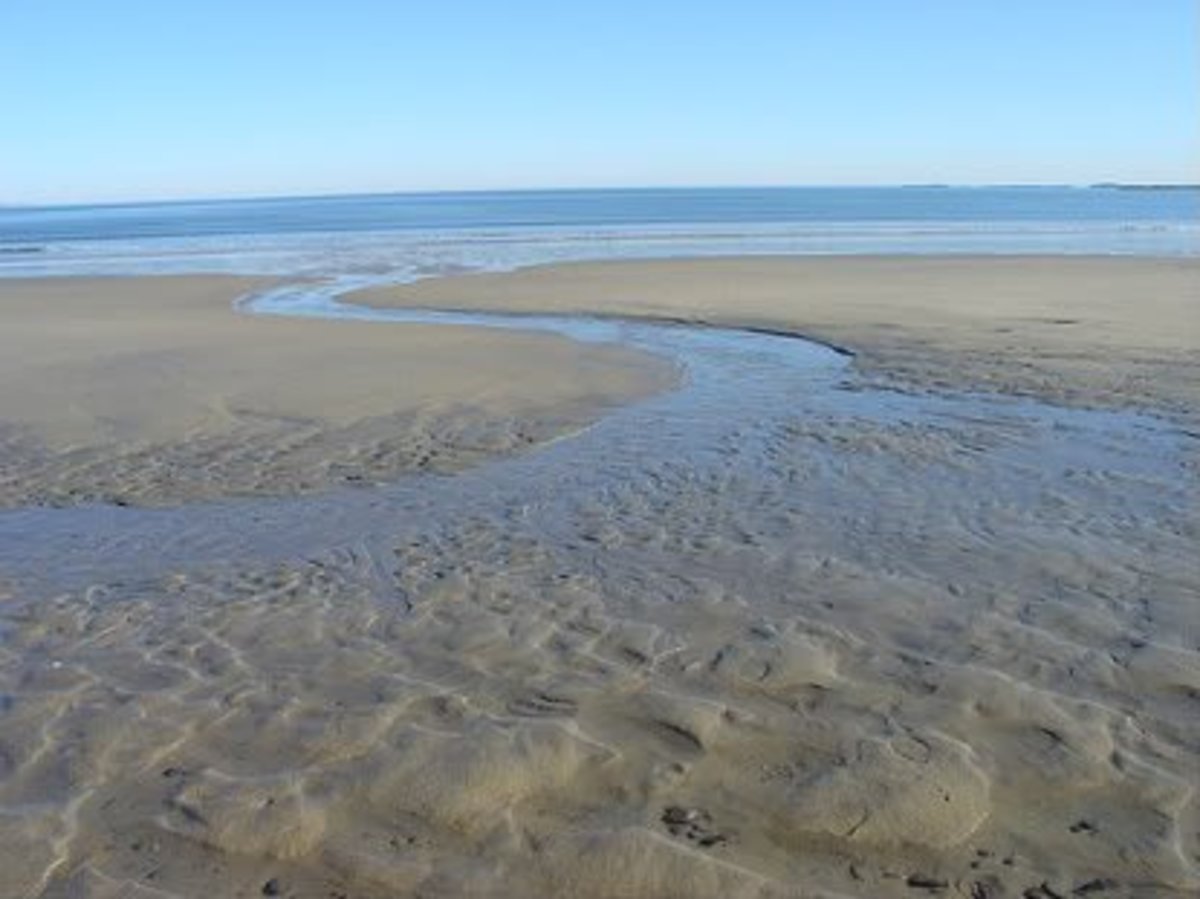
Check out the area at low tide, return at high tide.
Another
great surf fishing tip is to go and talk to a local tackle shop that is
close to the beach you are intending to fish. These places are
fantastic for gathering information about the fish species currently
being caught, where and when they are being caught, and what baits are
being used.
How Far to Cast?
Don't overdo it!
Sometimes the fish are much closer than you think . . .
Sometimes the fish are much closer than you think . . .
"All
Americans believe that they are born fishermen. For a man to admit to a
distaste for fishing would be like denouncing mother-love and hating
moonlight."
John Steinbeck -1954
John Steinbeck -1954
Rigs and Baits for Some Favorite Surf Fish
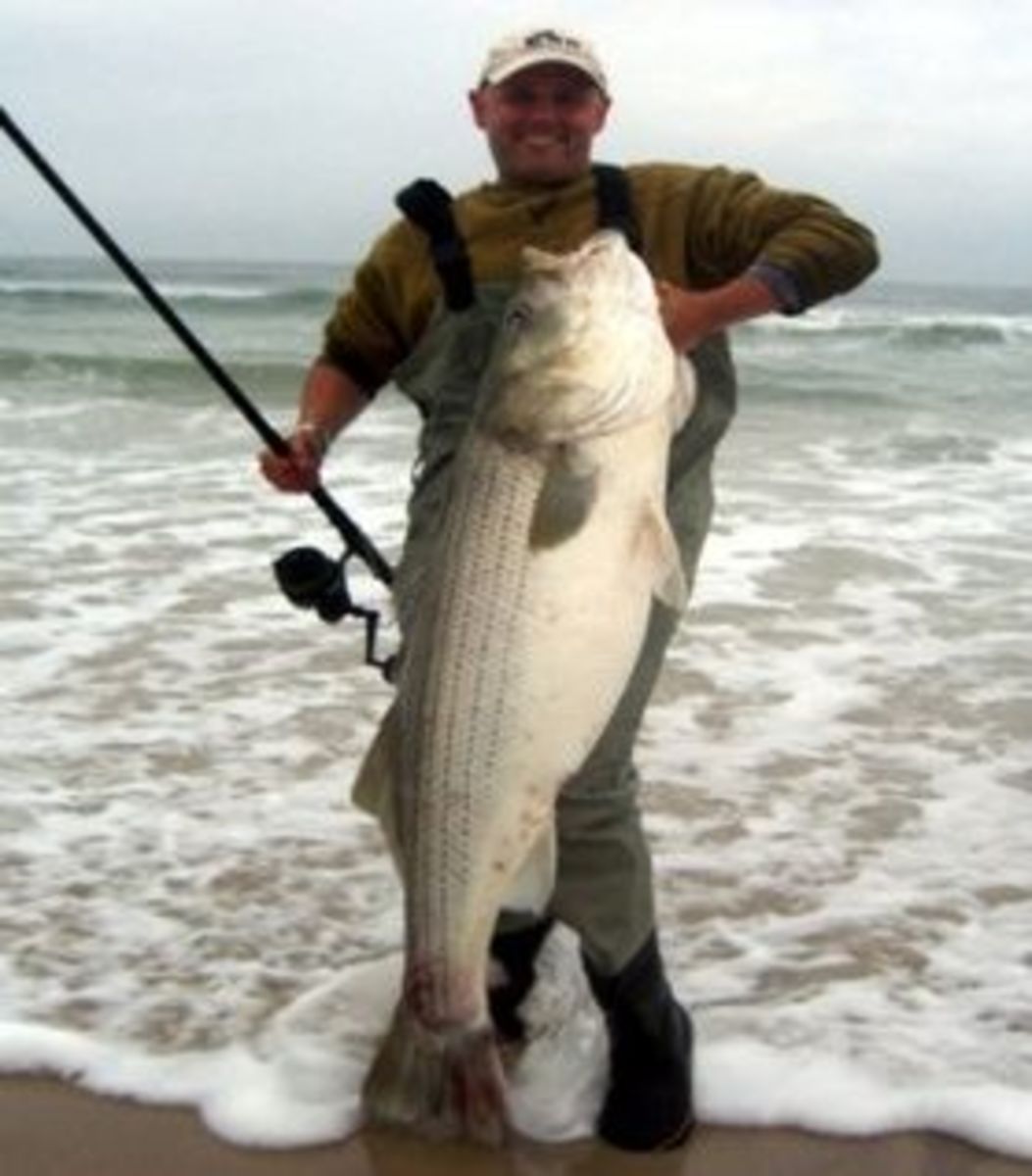
Monsters in the surf! A 55-pound striped bass.
Surf Fishing Tips for Striped Bass
If
you are a surf angler, hooking a sizable striped bass in the surf is
one of the most exciting experiences you can have. The secret is
choosing the right rig and the right bait for the job. Here are my two
favorite surf fishing rigs for this sought-after fish.
The Fish-Finder Rig for Striped Bass
The
fish-finder rig (illustrated further down in this article) works well
for bass because it allows the live bait to move naturally in the
current. Use live bait; eels hooked through the the tail are always the
top choice, followed by either menhaden or herring. Leader length
between hook and swivel should be around 20 inches. Attaching a weight
slide above the swivel will make the bait presentation much better than
in a fixed version. Striped bass have excellent eyesight, so try to keep
the rig as simple as possible.
The High-Low Rig for Striped Bass
There
are also many versions of the high-low rig, but this is the one that
seems to catch the most striped bass. This rig works well because
smaller bass tend to sit higher in the water while the larger fish will
stay closer to the bottom. For this surf fishing rig, tie two 5-inch
dropper loops on a 5-foot length of leader, keeping the loops around 12
inches apart, and tie your hooks to the end of the loops. Fifteen inches
below the bottom loop attach a weight snap, and 15 inches above the top
loop tie on a swivel for the main line. This rig works by getting the
fish to hook themselves, so circle hooks will work the best. Try using a
larger bait like bunker chunks on the bottom loop, and a slightly
smaller bait like blood worms for the top loop.
Surf Fishing Tips For Red Drum

Red drum
Red Drum Rig
If
you are after red drum, you will have to beef up your end tackle.
IIustrated below is a rig that should hold most large red drum.
For live baits try using live menhaden or shrimp. Chunks of crab also work well.
For live baits try using live menhaden or shrimp. Chunks of crab also work well.
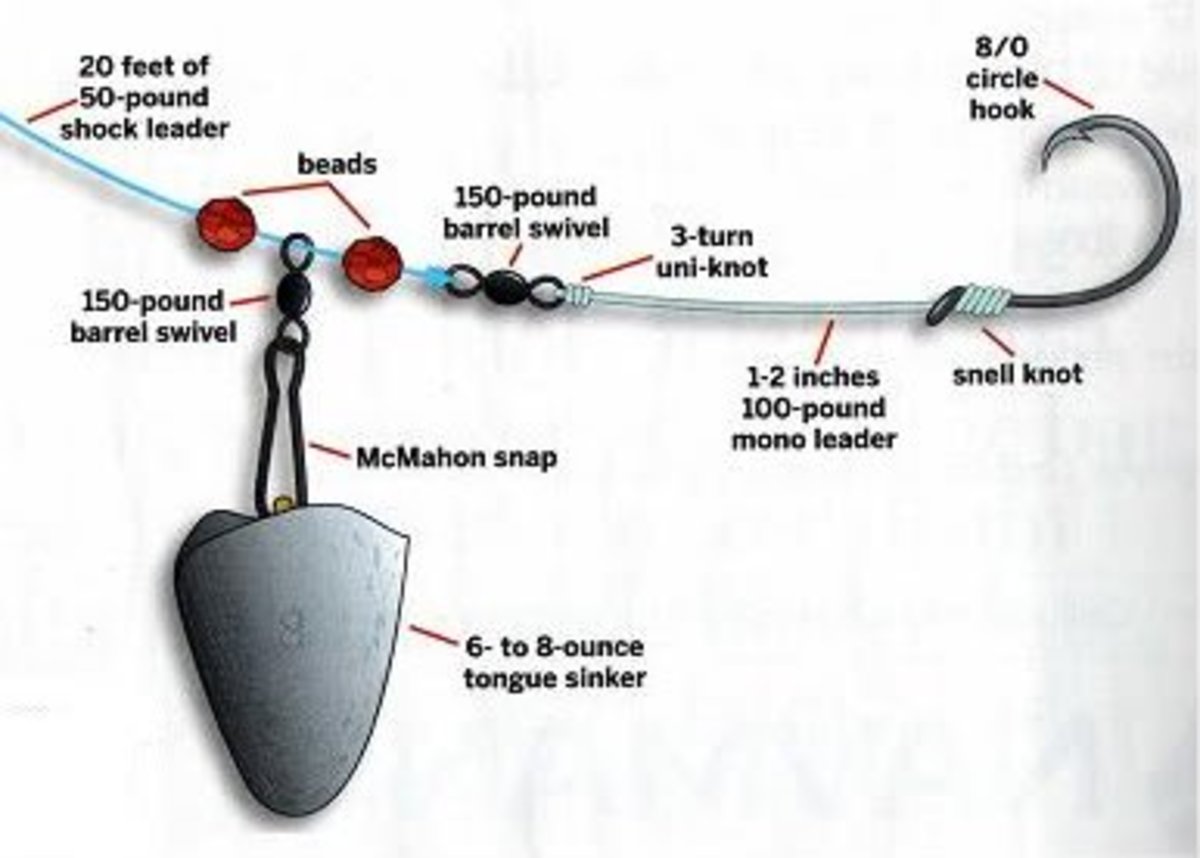
A rig for large red drum
Surf Fishing Tips For Bluefish
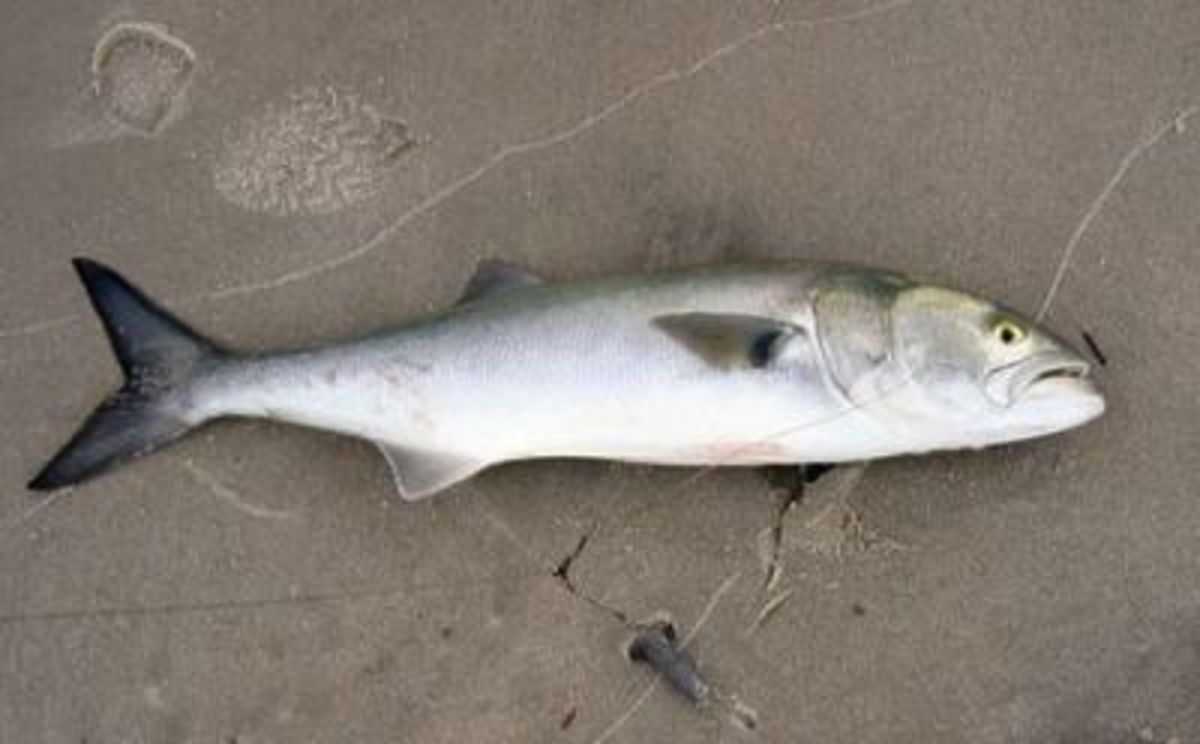
Bluefish
The
bluefish has extremely sharp teeth, so regardless of which rig you
choose, a wire leader is advisable. The best bait rig to use is the fish
finder rig. The wire leader length should be around 18 inches between
hook and swivel. Put a weight slide on the main line and then tie the
main line to the swivel. Bluefish have very good vision, so a
free-lining rig helps the bait look as natural as possible. Bluefish are
ferocious feeders and travel in large schools hunting smaller bait
fish, so for live baits try menhaden, mullet, eels, and shrimp. They
will also take most cut fish baits, with mullet being a favorite.
Lures For Bluefish
The majority of surf fishermen prefer to use artificial lures to catch bluefish. There are many lures you can use; popular ones are surface plugs, swimming plugs, jigs, and spoons. A fast stop-and-go retrieval will work the best for these fish, especially when using surface plugs. My personal favorite is a heavy silver spoon, which will cast a good distance and retrieve at speed. A good tip is to lace the spoon with a cut strip of mullet or similar fish; this will leave a strong scent trail as you retrieve the spoon. Spraying your lure with menhaden bait spray will have the same effect.
The average size of a school fish is two to five pounds, so light spinning tackle will give you some great sport. The bluefish has very strong jaws and sharp teeth, so when you do land it, take great care when removing the hook; use long-nosed pliers at all times.
Lures For Bluefish
The majority of surf fishermen prefer to use artificial lures to catch bluefish. There are many lures you can use; popular ones are surface plugs, swimming plugs, jigs, and spoons. A fast stop-and-go retrieval will work the best for these fish, especially when using surface plugs. My personal favorite is a heavy silver spoon, which will cast a good distance and retrieve at speed. A good tip is to lace the spoon with a cut strip of mullet or similar fish; this will leave a strong scent trail as you retrieve the spoon. Spraying your lure with menhaden bait spray will have the same effect.
The average size of a school fish is two to five pounds, so light spinning tackle will give you some great sport. The bluefish has very strong jaws and sharp teeth, so when you do land it, take great care when removing the hook; use long-nosed pliers at all times.
Pompano
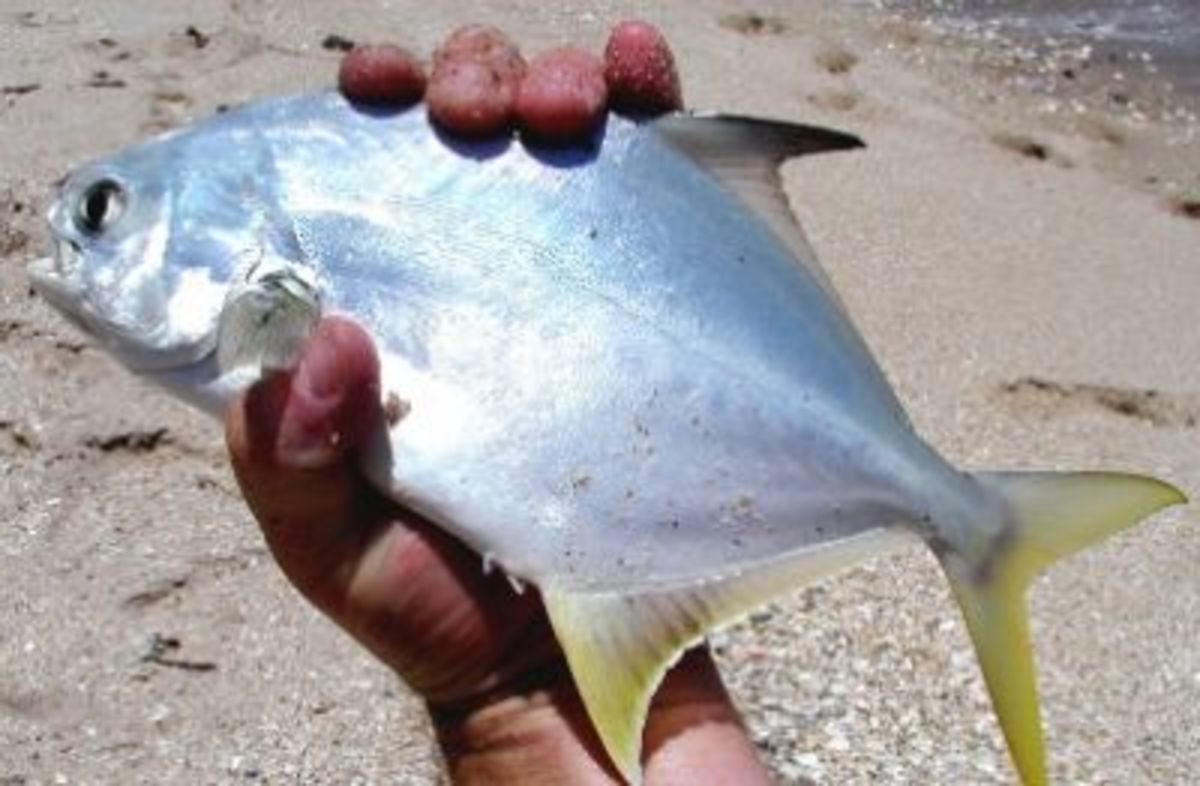
Pompano
Rigs
Three Popular Rigs for Surf Fishing
Don't
spend too much time on end rigs. A good principle for surf fishing rigs
is to keep them simple. The less there is to get tangled, the better.
Below are three very popular and simple surf fishing rigs.
Below are three very popular and simple surf fishing rigs.
The Fish-Finder Rig
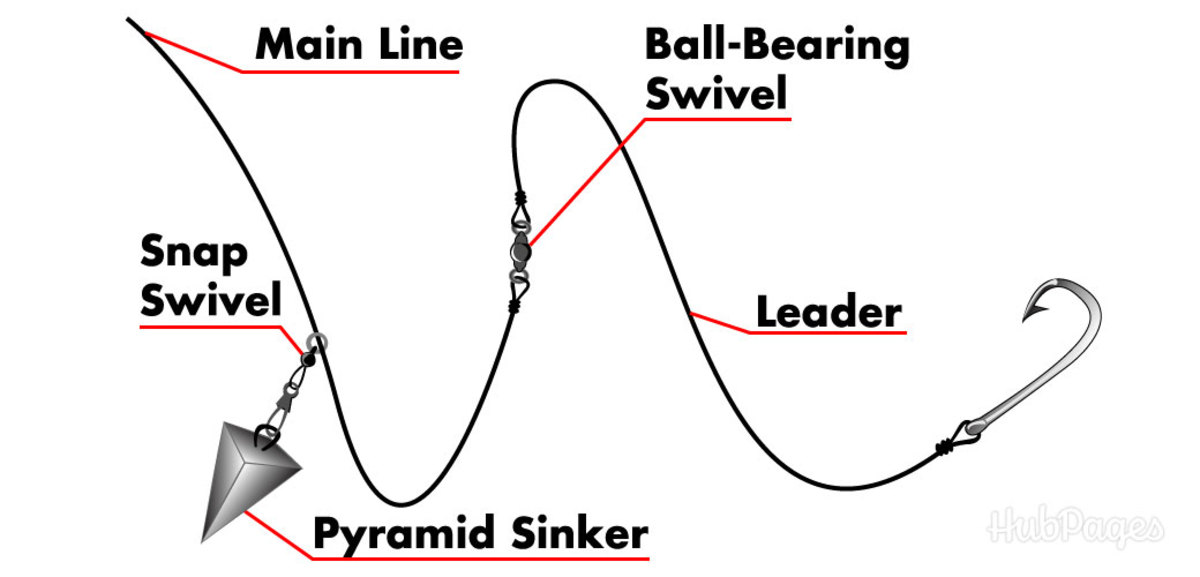
The
object of the fish-finder rig is to pose as little resistance as
possible as your target fish picks up the bait. It is entirely your
preference how long to make the leader, but the average length is around
24 inches.
It is very simple to make the fish-finder rig yourself.
It is very simple to make the fish-finder rig yourself.
The Fireball Rig
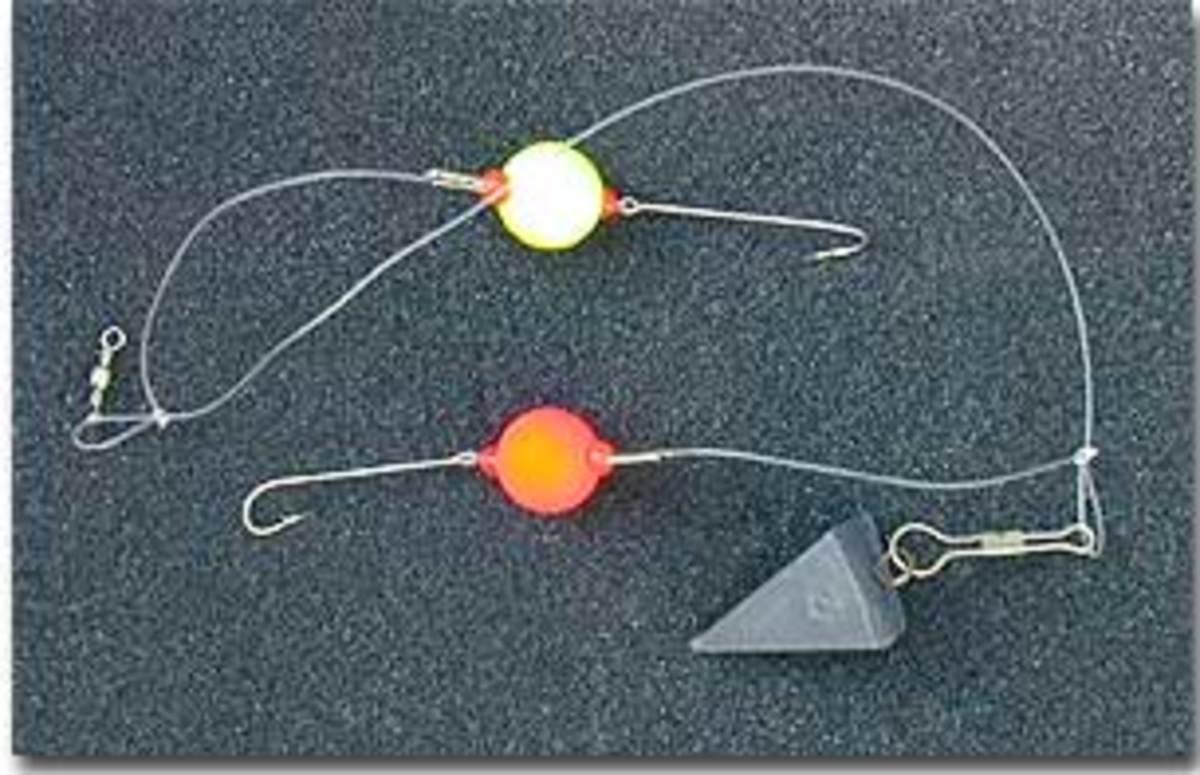
The
idea of the fireball rig is that the foam balls keep the bait slightly
off the bottom. The bright colors and movement in this rig make it a
great choice on days when the surf is rough and the water is cloudy.
The rig works well when fished with natural bait.
You can make up the fireball rig yourself but it is a little more involved, so it's much easier to buy them already made up.
The rig works well when fished with natural bait.
You can make up the fireball rig yourself but it is a little more involved, so it's much easier to buy them already made up.
The High-Low Rig
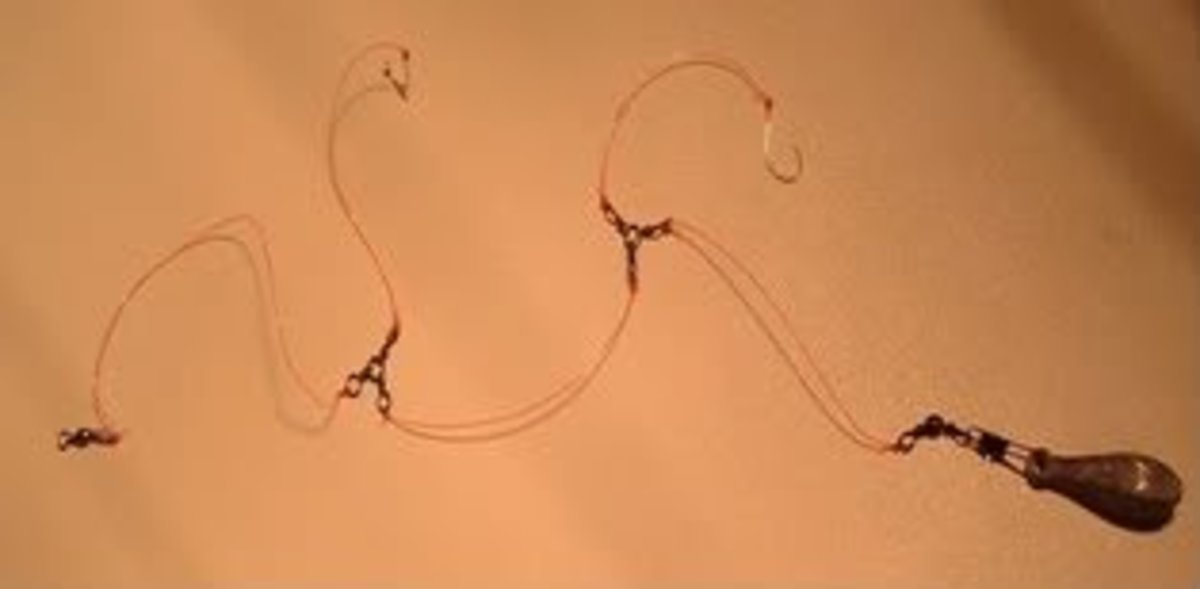
The
high-low rig is one of the best natural bait rigs there is. The rig
works extremely well for most large predatory fish, and gives you the
advantage of having two baits in the water. The rig can be made up
fairly easily, or can be bought ready made from your tackle shop.
Video: How to Tie Your Own Dropper Loop for Making Rigs
Video: How to Tie the Rapala Knot (Slightly More Difficult)
Natural Baits
Surf Fishing Bait Tips—Which Baits for Which Fish?

Pacific mole crab digging into wet sand | Source
Mole crabs
(also called sand crabs) are one of the most popular baits used for
surf fishing. Dig them yourself, and keep them in some damp sand. Will
catch most species, but best for redfish, whiting, pompano, striped
bass, blackfish, and black drum.

Squid | Source
Squid
are great bait for surf fishing. Buy them fresh or frozen, and use
whole or cut into strips. Good for bluefish, striped bass, and redfish.

Ragworm | Source
Sandworms or ragworms are another great bait for surf fishing. Dig your own or buy from your local tackle shop.
Good for: rockfish, striped bass, flounder, whiting, blackfish, porgy, sea trout, and surf perch.
Good for: rockfish, striped bass, flounder, whiting, blackfish, porgy, sea trout, and surf perch.

Live shrimp sold for bait | Source
Shrimp are a good all round bait, will catch just about any kind of fish! Can be used dead or live.

Mullet | Source
Mullet
are excellent bait and will catch a variety of fish. Use whole, dead or
alive, for larger fish or cut strips for smaller species.
Good for: bluefish, striped bass, tarpon, redfish, and sea trout.
Good for: bluefish, striped bass, tarpon, redfish, and sea trout.

Fiddler crabs in a baggie | Source
Use crabs whole, or use pieces for smaller fish. Soft-shell crab tends to get more takers than hard-shell crab.
Good for: black drum, tarpon, redfish, and snook.
Good for: black drum, tarpon, redfish, and snook.

Glycera (bloodworm) | Source
Dig your own bloodworms, or buy them from your tackle shop.
Good for flounder, sea trout, striped bass, bluefish, porgy, and whiting.
Good for flounder, sea trout, striped bass, bluefish, porgy, and whiting.
Lures
Surf Fishing Lures: Surf-Fishing Tips For Artificial Bait
Always pack a good selection of plugs, spoons, and other forms of artificial baits.
Depending on what you are after, artificial bait can be just as good as, if not better than, the real thing. Find out from local anglers which lures are taking fish.
Depending on what you are after, artificial bait can be just as good as, if not better than, the real thing. Find out from local anglers which lures are taking fish.
Three Lures Every Surf Angler Should Have
Surf
fishing lures are a topic of much debate among surf anglers. The
multitude of different sizes and colors make choosing the right one a
little confusing. Here are three surf fishing lures that every surf
angler should have in their bag.
Metal Spoons

Metal spoon fishing lure | Source
The
large metal spoon is supposed to resemble a large bait fish such as
menhaden or mullet. Most are chrome or bright silver in color. Most surf
fishermen using a large metal spoon are after bluefish, but almost any
fish will take them. These streamlined two- to four-ounce spoons will
reach most outer bars with ease. Jigging the spoon on a medium fast
retrieval tends to bring good results. If you are after bluefish
remember to attach a 12-inch wire trace before the lure.
Lead-Head Soft Plastic Tail Jigs

Rubber fake fish of different colors threaded onto lead-weighted hooks
The
great thing about this type of lure is the variety of combinations
available. The action of the lure on retrieval will vary with your
choice of tail, so always carry a few different colors and sizes in your
bag for a quick change. Changing your choice of tail is a simple matter
and can be done quickly and easily. You can use many types of retrieval
when using the combination jig, but employing a slow and steady
retrieve will see the most takes. Heavy monofilament line will affect
the jig's performance, so try and use a short length of lightweight
leader.
Small Metal Lures

Small metal lures don't have to be this colorful—any minnow-sized bit of metal, with or without a brushy tail, may work.
The
smaller metal surf fishing lures are great for use with light spinning
tackle. A seven- to nine- foot spinning rod and a reel loaded with 10-
to 12-lb mono-filament main line will allow you to use this type of lure
to its full effect. The lure itself is designed to resemble a minnow,
and when used on a fast retrieve will attract small to medium-sized
bluefish. A very slow retrieve keeping the lure close to the bottom will
produce trout and smaller striped bass.
There are many more surf-fishing lures available, but these three lures will ensure you have a lure that will produce fish on almost every occasion.
There are many more surf-fishing lures available, but these three lures will ensure you have a lure that will produce fish on almost every occasion.
Other Surf-Fishing Equipment
Surf Fishing Tips - Your Equipment - Less Is More...

The
beauty of surf fishing (or any type of rod and line fishing for that
matter) is that you do not need much equipment to get started.
Everything you need for a day of surf fishing will fit into a small to
medium-sized tackle box.
You can set yourself up with everything you need for about $120, and rod-and-reel combos start at around $60, but as with most things you get what you pay for. Spend as much as you can afford on a quality rod and reel; properly looked after, they will last you many years.
You can set yourself up with everything you need for about $120, and rod-and-reel combos start at around $60, but as with most things you get what you pay for. Spend as much as you can afford on a quality rod and reel; properly looked after, they will last you many years.
Three things I always take surf fishing:

- Torch (flashlight)
- Nail clippers
- Cell phone (in a sealable plastic bag!)

Saltwater Spinning Reel for Corrosion Resistant Buy Now Save 10% each on New Year Discount offered Enter code L2WVCG3C
The Surf Fisherman's Friend
I've tried many blades, pliers and pocket knives over the years, but this little tool has served me well.
A handy size, lightweight and very strong, an excellent addition to any fishermans kit.
A handy size, lightweight and very strong, an excellent addition to any fishermans kit.
Leatherman 81030003K Squirt S4 Inferno Multitool with Small Scissors
Top quality stainless steel and highly visible.
A Quick Surf-Fishing Checklist
- Surf-fishing rod (ten- to twelve-foot medium action rod, with silicon carbide line guides and non corrosive reel seats)
- Reel (open-faced with a bail arm; choose the best you can afford)
- Live Bait Rigs (four or five, ready-made)
- Surf lures (a small selection)
- Artificial bait (a small selection)
- Spare hardware (sinkers, hooks, swivels, etc.)
- Tools (needle-nose pliers, knife)
- Miscellaneous (rod spike, rags, plastic bags, baitbox/bait bucket)
Above all be safe and have fun!




No comments:
Post a Comment